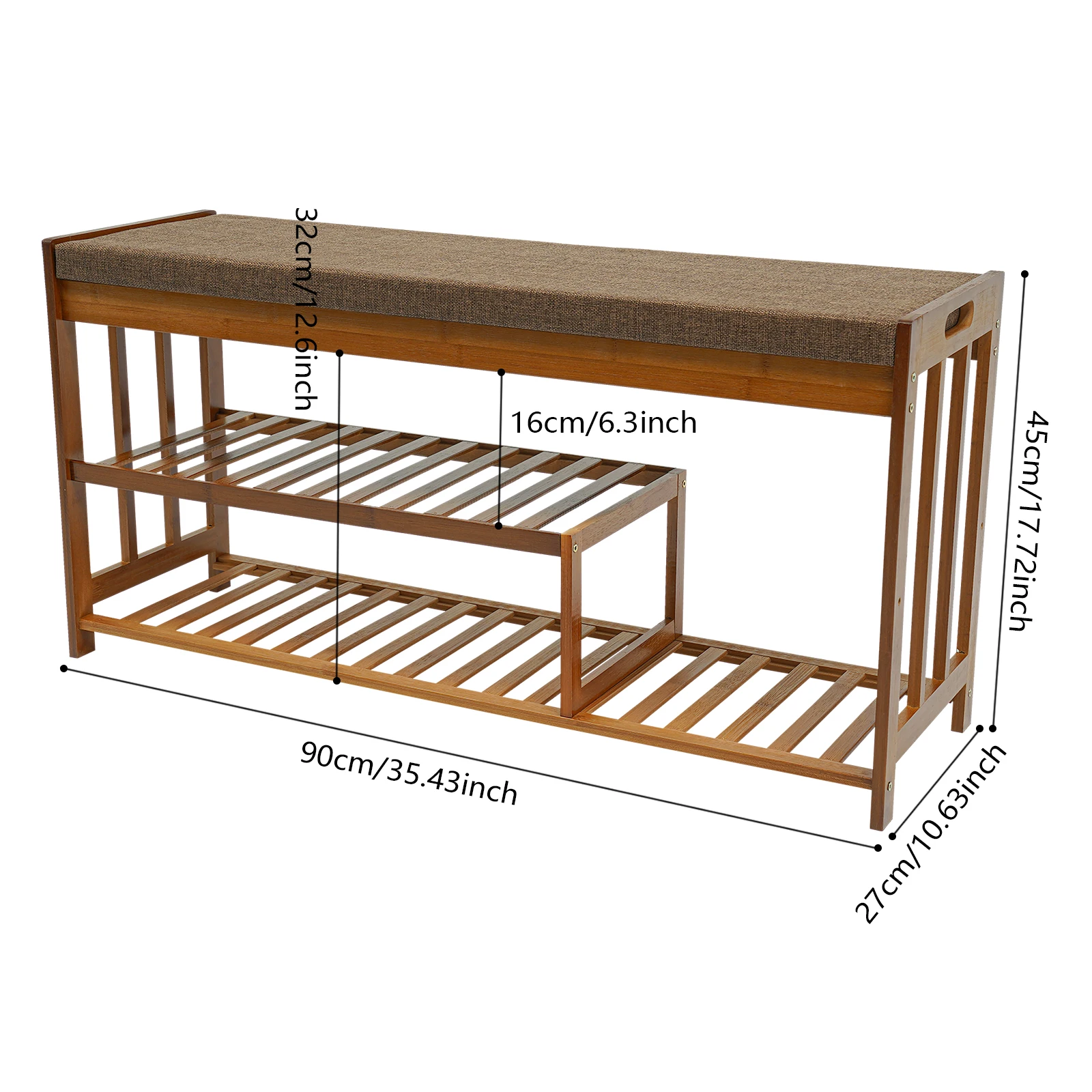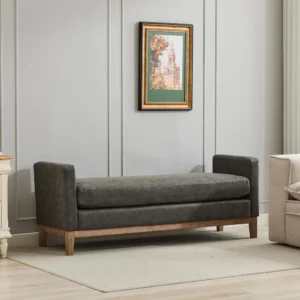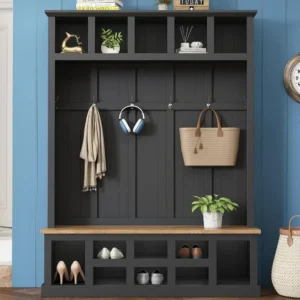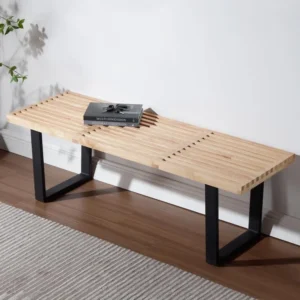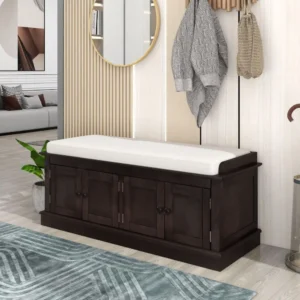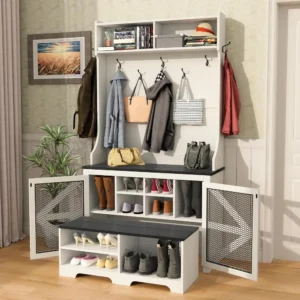What is a Multi-Purpose Utility Room Bench?
A multi-purpose utility room bench is a versatile piece of furniture specifically designed to serve multiple functions while maximizing limited space in utility areas. Unlike standard benches that provide seating alone, these specialized benches combine comfortable seating with practical storage solutions and additional functionalities tailored to utility room needs.
What makes these benches truly special is their thoughtful design that addresses the unique challenges of utility spaces. They typically feature built-in storage compartments, cubbies, shelves, or drawers that allow you to organize everything from cleaning supplies to laundry essentials. Many models also incorporate specialized features like shoe storage racks, coat hooks, or folding surfaces.
These benches differ from general home benches in their construction materials and design elements that withstand the potentially damp, high-traffic environment of utility rooms. The materials are often moisture-resistant and easy to clean, making them perfectly suited for spaces where water, mud, and household chemicals might be present.
Understanding the benefits of functional mudroom seating solutions can help you make better decisions when organizing your utility spaces. Whether you’re dealing with a dedicated laundry room or a multi-functional mudroom area, the right mudroom bench can transform how you use and experience these essential home spaces.
9 Key Benefits of Multi-Purpose Benches for Utility Spaces
Maximizes Limited Space
Multi-purpose benches make the most of vertical and horizontal space in typically cramped utility rooms. By combining seating, storage, and work surfaces into one piece of furniture, these benches can reduce the footprint needed by up to 40% compared to separate furniture pieces. This space efficiency is crucial in utility rooms that often compete for limited square footage.Enhances Organization
The integrated storage compartments in utility benches create designated places for items that might otherwise clutter your space. With separate sections for different categories of items, you can establish organization systems that reduce visual chaos and make finding things easier.Provides Essential Seating
Having a comfortable place to sit in your utility room transforms how you use the space. Whether you’re putting on shoes, folding laundry, or taking a quick break between chores, built-in seating makes everyday tasks more comfortable and convenient without requiring additional furniture.Creates Work Surface
Many utility benches offer flat surfaces that serve as impromptu workstations. This additional counter space becomes invaluable for folding clothes, sorting mail, potting plants, or any other task that benefits from a dedicated work area.Improves Room Aesthetics
A well-designed bench can elevate the visual appeal of your utility room, transforming it from purely functional to stylishly practical. These benches create a cohesive look that helps utility spaces feel like intentional, designed areas of your home rather than afterthoughts.Offers Versatile Storage Solutions
The variety of storage options—drawers, cubbies, cabinets, and shelves—allows for customizable organization based on your specific needs. This versatility means your bench can adapt to changing storage requirements throughout the seasons or as your household needs evolve.Increases Home Value
Thoughtfully designed utility spaces with smart storage solutions can boost your home’s appeal to potential buyers. Real estate experts note that organized utility rooms with built-in functionality rank high on homebuyers’ wish lists.Reduces Daily Stress
The psychological benefits of an organized, functional utility room shouldn’t be underestimated. Having systems in place reduces the mental load of household management and creates a sense of control in spaces that can easily become chaotic.Withstands Utility Room Conditions
Quality multi-purpose benches are designed with durable materials that can handle the unique challenges of utility spaces—moisture from laundry, dirt from outdoor gear, and the wear and tear of daily use. This durability ensures your investment lasts for years despite demanding conditions.
Understanding the versatility of multi-functional mudroom benches can transform how you approach utility room organization. The right entryway bench storage solution combines practical functionality with space-saving design to make the most of your utility area.
5 Most Popular Types of Multi-Purpose Utility Room Benches
Storage-First Benches
Storage-first benches prioritize maximum storage capacity while still providing seating. These models typically feature large internal compartments accessed through lift-top seats that open on hinges or hydraulic lifts. The spacious interiors accommodate bulky items like extra linens, seasonal gear, or rarely used appliances. Other variations include drawer-based models with multiple pull-out compartments for categorized storage of smaller items. Cubby systems offer open-faced storage compartments that keep items visible and accessible—ideal for daily essentials that you don’t want hidden away.
Seating-Focused Benches with Storage
When comfort is a priority but storage remains important, seating-focused designs offer the best of both worlds. These benches feature cushioned tops with varying levels of padding and upholstery options that withstand utility room conditions. The storage elements are typically simplified—often a shelf underneath for shoes or baskets. For extremely limited spaces, fold-down seating options attach to the wall and can be tucked away when not in use, leaving floor space open for other activities.
Shoe Storage Specialists
Shoe organization is a common challenge in utility rooms and mudrooms, making specialized shoe storage benches particularly valuable. Tiered designs accommodate multiple pairs on shelves of varying heights, while boot-friendly versions feature taller compartments that prevent tall footwear from toppling over. Slatted options allow air circulation around wet shoes or boots, speeding drying time and reducing odors—a thoughtful feature for rainy or snowy climates.

Laundry Station Benches
Designed specifically for laundry room tasks, these benches incorporate features that streamline washing, drying, and folding routines. Models with multiple sorting compartments make separating lights, darks, and delicates effortless, while benches with integrated hampers keep dirty clothes contained until wash day. Some designs include folding surfaces at a comfortable height, which can be extended when needed and tucked away afterward to save space.
All-In-One Utility Centers
The most comprehensive option, all-in-one utility centers combine benches with extensive storage systems that maximize vertical space. Wall-to-ceiling designs incorporate hooks for hanging items, multiple shelves, cabinets, and a seating area—creating a complete organization station within a compact footprint. Modular systems offer flexibility to add or reconfigure components as your needs change, making them adaptable to growing families or evolving storage requirements.
Understanding what a mudroom bench entails can help you select the right type for your space. For homes where footwear organization is a priority, specialized mudroom bench shoe storage options provide tailored solutions to keep entryways tidy.
Choosing the Perfect Materials for Your Utility Room Bench
Solid Wood Options
Solid wood benches bring natural warmth and timeless appeal to utility spaces. Woods like oak and maple stand up well to daily use thanks to their dense grain structure and resistance to dents. In utility rooms, solid wood requires proper sealing to protect against moisture, but once treated, these benches can last for generations with proper care. While the initial investment is higher than other materials, the ability to refinish wood surfaces means scratches or stains can be addressed without replacing the entire piece—making it economical over the long term.
Engineered Wood and Composites
Medium-density fiberboard (MDF), plywood, and particleboard with laminate or veneer finishes offer cost-effective alternatives to solid wood. These materials provide stable surfaces that resist warping when properly sealed. The factory-applied finishes often include moisture-resistant properties ideal for utility rooms. While they generally can’t be refinished like solid wood, their lower price point makes replacement after many years of service more economical. Modern engineered wood products have improved significantly in durability and appearance, offering convincing wood-like aesthetics at a fraction of the cost.
Metal Construction
Metal frames—typically steel or aluminum—offer exceptional strength-to-weight ratios and industrial aesthetic appeal. These benches withstand heavy loads and resist damage from moisture, making them ideal for hardworking utility spaces. Metal combines well with other materials, often serving as the structural frame with wood or upholstered elements for seating surfaces. The potential downsides include cold surface temperatures and occasional noise from metal-on-metal contact, though rubber buffers can minimize the latter concern.
Plastic and Polymer Options
High-density polyethylene (HDPE) and other advanced polymers create completely waterproof bench options that never rust, rot, or require painting. These materials are perfect for utility spaces prone to water exposure or high humidity. While the appearance might lack the premium feel of natural materials, modern manufacturing techniques have improved the visual appeal significantly. The lightweight nature of plastic benches allows for easy movement during cleaning or room reconfiguration—a practical advantage in multi-use spaces.
For utility rooms where classic appeal matters, wood mudroom benches offer the perfect balance of warmth and functionality. The natural variations in grain patterns add unique character while providing durable seating and storage solutions for high-traffic areas.
How to Measure Your Utility Room for the Perfect Bench
Finding the right-sized bench for your utility room starts with accurate measurements of your available space. Begin by measuring the wall length where you plan to place the bench, ensuring you account for any obstructions like outlets, vents, or light switches. For depth, measure perpendicular from the wall, considering that most utility benches require 16-24 inches (40-60 cm) of depth to provide comfortable seating while incorporating storage.
Door clearance is a critical factor often overlooked during planning. Measure the arc of any doors that swing into the space, and mark this area as a no-go zone for furniture placement. Allow at least 36 inches (91 cm) of clear space in front of your bench for comfortable movement and traffic flow.
For height considerations, standard benches measure 17-20 inches (43-51 cm) from floor to seat—comparable to chair height for comfortable sitting. If you’re planning a bench with upper storage components like hooks or cabinets, ensure there’s adequate vertical clearance for both seated users and standing activities.
When measuring for built-in options, be extra precise and take measurements at multiple points along your wall, as houses often have subtle variations that can affect fit. For freestanding units, add at least 2 inches (5 cm) of clearance on each side to allow for easy cleaning and a visually balanced appearance.
A common measurement mistake is forgetting to account for baseboard heaters or trim—make sure to measure from the wall itself, not from any protruding elements that might affect how flush your bench can sit against the wall.
For utility spaces with limited width, exploring narrow entryway bench options can help maximize functionality without compromising movement through the space.
Smart Organization Ideas Using Your Multi-Purpose Bench
Laundry Station Organization
Transform your utility bench into an efficient laundry command center by designating specific storage areas for different supplies and tasks. Install a tension rod under the bench for hanging delicates or freshly ironed clothes. Use the bench surface for folding, with pull-out baskets underneath labeled for different family members—making distribution of clean clothes straightforward. Store detergents and stain removers in spill-proof containers within closed compartments to keep them away from curious children while remaining accessible for regular use.
Entryway/Mudroom Organization
Create a streamlined entry system by assigning bench storage sections to each family member. Use color-coded baskets that slide into cubbies for smaller items like gloves and scarves, while shoes can be arranged on lower shelves. Reserve prime bench storage for seasonal items currently in use, rotating winter gear to less accessible storage when spring arrives. Keep frequently used items like pet leashes and umbrellas on hooks at eye level for grab-and-go convenience.
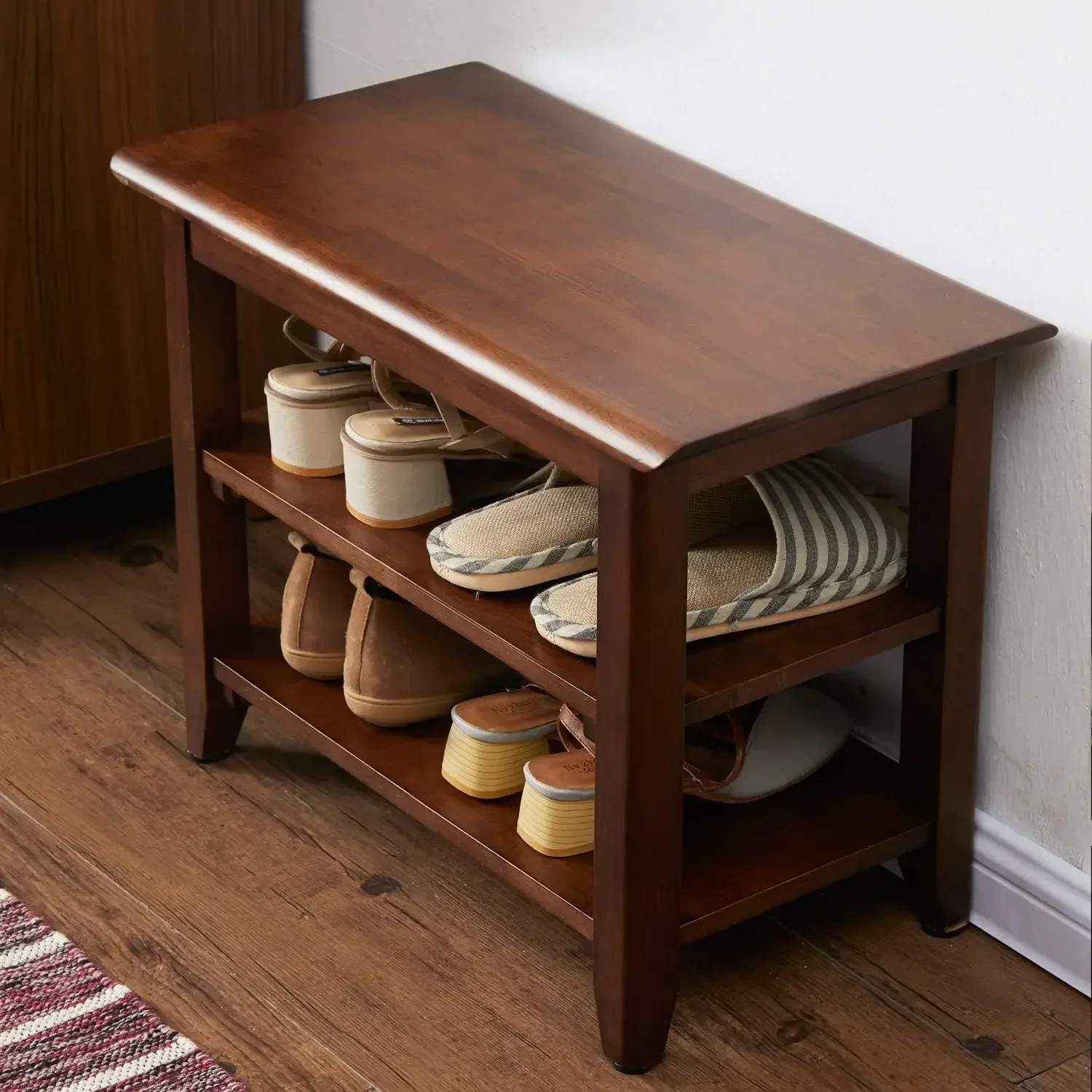
Cleaning Supply Storage Strategies
Organize cleaning supplies by room or task rather than product type to streamline housekeeping routines. Store frequently used items at eye level in open compartments, while keeping potentially hazardous products in childproof latched drawers or cabinets. Use turntables inside deep bench storage areas to make back-row items easily accessible without digging. Clear containers with labels ensure everyone knows what’s available and where to find it, reducing duplicate purchases of supplies.
Accessorizing Your Bench for Maximum Organization
Enhance your bench’s organizational potential with strategically chosen accessories. Add adjustable shelf dividers to prevent stacked items from toppling over. Install small tension rods vertically between shelves to create divisions for storing cutting boards, baking sheets, or mail. Attach magnetic strips to the inside of cabinet doors for holding metal tools or scissors. Complement your bench storage with wall-mounted solutions directly above—creating vertical storage zones that work in tandem with your bench system.
Implementing effective practical bench organization strategies can dramatically improve utility room functionality. For spaces serving multiple purposes, multi-functional seating for mudrooms offers versatile solutions that adapt to changing household needs throughout the day.
Designing Your Utility Room Around a Multi-Purpose Bench
Your utility bench can serve as the anchor piece that defines both the function and style of the entire room. Start by positioning the bench where it creates natural workflow patterns—typically along the longest uninterrupted wall or under windows that provide natural light for tasks.
When selecting colors and finishes, consider how the space connects to adjacent rooms. For utility rooms visible from main living areas, choose bench finishes that complement your home’s overall aesthetic while still standing up to utility room conditions. Neutral tones like warm grays, soft whites, and natural wood finishes create a timeless foundation that won’t compete with functional elements.
Lighting dramatically affects how welcoming and useful your utility space feels. Install task lighting directly above work areas of the bench, and consider under-bench lighting to illuminate lower storage areas and create a sense of dimension in smaller spaces. Pendant lights above seating areas add both practical illumination and a design element that elevates the space beyond purely utilitarian.
Integrate your bench with existing features by echoing design elements throughout the room. If your bench has black hardware, carry that finish to hooks, light fixtures, and cabinet pulls for visual cohesion. Create symmetry where possible, flanking the bench with matching storage towers or display shelves to frame the seating area.
Use the vertical space above your bench strategically by installing floating shelves, cabinets, or pegboards that extend the storage capacity without consuming floor space. This approach creates a custom built-in appearance even with freestanding pieces.
For comprehensive approaches to utility space design, exploring functional mudroom design guides can provide additional inspiration for creating spaces that perfectly balance appearance with practicality.
Essential Maintenance Tips for Long-Lasting Utility Benches
Proper maintenance ensures your utility bench remains functional and attractive for years to come. For wood benches, regular dusting with a soft cloth prevents buildup that can scratch surfaces over time. Clean spills immediately with a damp cloth and avoid harsh chemical cleaners that can strip protective finishes. Every six months, apply a quality wood conditioner to maintain moisture resistance and prevent cracking.
Metal components benefit from periodic checks for rust spots, particularly in humid utility rooms. Treat any emerging rust immediately with fine steel wool, followed by metal primer and touch-up paint. Apply a thin coat of paste wax annually to create a protective barrier against moisture without creating a slippery surface.
For upholstered bench seats, vacuum regularly using upholstery attachments to remove dust and debris from seams. Spot clean stains promptly using fabric-appropriate cleaners, working from the outside of the stain inward to prevent spreading. Consider applying fabric protector spray annually to guard against water spots and staining.
Hardware requires attention too—check for loose screws or hinges quarterly and tighten as needed. Apply a drop of clear nail polish to screws that repeatedly loosen to create a temporary thread-lock. Lubricate hinges and drawer slides annually with a silicone-based product that won’t attract dust.
Watch for warning signs that indicate deeper issues: drawers that stick, doors that don’t close properly, or visible sagging in seating surfaces. Addressing these problems early prevents more significant damage and extends your bench’s useful life.
For utility spaces with cabinet-style storage, proper maintenance of mudroom bench cabinets ensures smooth operation and prevents potential moisture damage in these hardworking areas.
How to Choose the Perfect Multi-Purpose Utility Bench: Buyer’s Guide
Selecting the ideal utility bench begins with a clear assessment of your primary needs. Start by listing your top three storage priorities and the activities you’ll perform in the space. This clarity helps narrow options and prevents investing in features you won’t use regularly.
Quality construction indicators include dovetail or mortise-and-tenon joints for wood pieces, welded (rather than just bolted) connections for metal frames, and reinforced stress points where weight bears down most heavily. Examine weight capacities for both seating (typically 250-400 pounds) and storage shelves (varying widely from 20-100 pounds per shelf).
When evaluating features, prioritize those addressing your daily pain points. If shoes constantly clutter your floor, shoe storage becomes essential. If laundry sorting causes frustration, compartmentalized storage might justify a higher price point. Consider which convenience features truly matter for your household’s routines rather than paying for impressive-sounding features you may rarely use.
Entryway Bench with Cushion, Mudroom Bench with Cushion, Shoe Bench for Entryway
$1,186.63 Select options This product has multiple variants. The options may be chosen on the product pageBench with Hooks and Storage, Entryway Hall Tree, Mudroom Bench with Cubbies, Mudroom Bench with Shoe Storage
$818.38 Select options This product has multiple variants. The options may be chosen on the product pageModern Entryway Bench, Wood Entryway Bench, Wood Mudroom Bench
$497.69 Select options This product has multiple variants. The options may be chosen on the product pageEntryway Coat Rack Bench, Entryway Hall Tree, Farmhouse Mudroom Bench, Mudroom Bench with Shoe Storage
$805.09 Select options This product has multiple variants. The options may be chosen on the product pageEntryway Bench with Cushion, Mudroom Bench with Cabinets, Shoe Bench for Entryway, Shoe Bench with Cushion
$991.71 Select options This product has multiple variants. The options may be chosen on the product pageBench with Hooks and Storage, Entryway Coat Rack Bench, Entryway Hall Tree, Mudroom Bench with Shoe Storage, Mudroom Coat Rack Bench
$793.73 Select options This product has multiple variants. The options may be chosen on the product page
Before purchasing, verify dimensions carefully against your measurements, accounting for any assembly variations that might affect the final size. Research delivery options, as larger benches may require freight shipping with special scheduling and potential additional fees. Assembly complexity varies dramatically between models—factor in your comfort with tools and the potential need for professional assembly for particularly complex pieces.
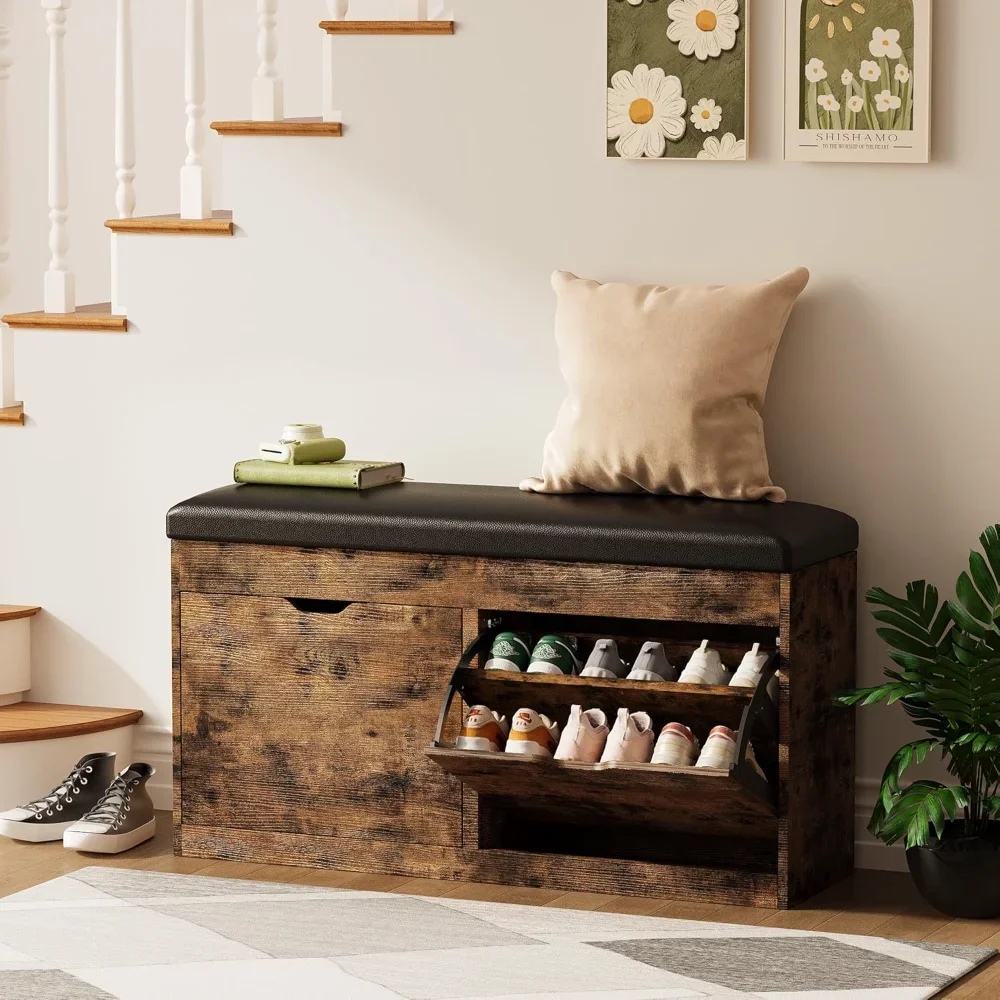
For contemporary utility spaces that blend function with aesthetic appeal, modern storage benches for small spaces offer sleek solutions that maximize functionality without overwhelming limited square footage.
Can You DIY? Building Your Own Custom Utility Room Bench
Creating your own utility room bench can be a rewarding project that delivers a perfectly customized solution for your space. The complexity and required skill level varies significantly based on your design ambitions. Simple bench projects with basic storage can be completed with beginner to intermediate woodworking skills, while more elaborate designs with custom storage configurations require advanced skills and specialized tools.
For a basic bench with lower shelf storage, you’ll need common tools like a circular saw, drill, sander, and basic measuring tools. Materials typically include lumber (pine is beginner-friendly and affordable), plywood for storage components, screws, wood glue, and finishing materials like paint or stain. Expect to invest 8-12 hours for a straightforward project, spread over a weekend to allow for drying time between steps.
The cost advantage of DIY can be significant—a custom bench that might retail for $300-600 can often be built for $100-200 in materials. This savings comes at the cost of your time and effort, so evaluate whether the customization and cost benefits outweigh the convenience of ready-made options.
Plans for beginner-friendly utility benches are widely available online, ranging from simple box designs to more complex arrangements with drawers and cubbies. Start with a simpler design for your first project, as successful completion builds the confidence and skills needed for more ambitious future projects.
The greatest advantage of DIY is customization—you can tailor dimensions to the exact measurements of your space and create storage compartments sized for specific items you need to organize. For unique spaces or unusual storage needs, this customization can solve problems that off-the-shelf furniture simply can’t address.
For those interested in creating personalized solutions, exploring DIY mudroom benches for limited spaces can provide practical guidance for projects scaled to your specific utility room dimensions and requirements.
Is a Multi-Purpose Bench Right for Your Specific Utility Room?
To determine if a multi-purpose bench suits your utility room, ask yourself these key questions: Do you regularly perform seated tasks in this space, like putting on shoes or sorting laundry? Would consolidating storage and seating free up valuable floor space? Is clutter a persistent problem in your utility area? If you answered yes to any of these questions, a multi-purpose bench likely offers significant benefits for your situation.
For extremely compact utility spaces under 30 square feet (2.8 square meters), consider wall-mounted folding options that can be tucked away when not in use. Alternatively, a narrow console table with baskets underneath might serve storage needs while maintaining open floor space for movement.
The best candidates for utility benches are rooms where multiple activities occur—spaces that serve as laundry rooms, mudrooms, pet care areas, or entryways. The more functions your utility room serves, the greater the organizational benefit a multi-purpose bench provides.
If your utility room has unusual architectural features like sloped ceilings or awkward corners, look for modular bench systems that can be configured to work with these constraints. Custom or DIY solutions may also better accommodate challenging spaces than standard pre-made options.
For households with young children or aging family members, benches provide valuable sitting areas that make the utility room more accessible and functional for everyone. Consider models with rounded corners and sturdy construction if safety for young children is a priority.
Homeowners with particularly small utility spaces can find tailored solutions through small home mudroom bench solutions that maximize functionality without overwhelming limited square footage.
How Do Multi-Purpose Benches Compare to Other Utility Room Storage?
When evaluating storage options, multi-purpose benches offer unique advantages over alternative solutions. Unlike standalone cabinets that provide enclosed storage but no functional surface, benches deliver both storage and usable seating or workspace. While wall-mounted shelving maximizes vertical space without consuming floor area, it lacks the multifunctional benefits of seating that benches provide.
From a space efficiency standpoint, benches occupy a middle ground—using more floor space than wall solutions but offering greater functionality per square foot than most single-purpose furniture. A typical 48-inch bench with storage occupies about 8 square feet but replaces both seating and storage units that might collectively require 12-15 square feet.
Cost comparisons reveal benches as moderately priced options, with basic models starting around $150 and premium versions ranging up to $600. Custom cabinetry generally commands higher prices starting at $300 per linear foot, while basic shelving systems can be installed for as little as $100 but offer significantly less functionality.
The most effective utility rooms often combine multiple storage types—benches for frequently used items and seating, tall cabinets for bulk storage or rarely used items, and wall systems for visual access to everyday essentials. This layered approach creates a comprehensive organization system that addresses different storage needs within the same space.
What Should You Store in Your Utility Room Bench?
Utility room benches excel at storing items that benefit from both protection and accessibility. Items used several times weekly—like pet supplies, cleaning basics, or shoe care products—are perfect candidates for bench storage. The ideal contents are those neither so frequently used they need constant access nor so rarely used they can be stored in less accessible locations.
For bench cubbies and open shelving, consider storing:
– Shoes and boots currently in season
– Pet leashes, toys, and grooming tools
– Folded reusable shopping bags
– Everyday cleaning supplies
– Children’s outdoor accessories
For enclosed bench storage like drawers or cabinets, optimal items include:
– Seasonal outdoor accessories (gloves, hats, sunscreen)
– Laundry supplies in daily use
– Shoe care products
– Extra household supplies (paper towels, tissues)
– Guest slippers or indoor footwear
Avoid storing items sensitive to temperature fluctuations or humidity in utility benches, particularly near laundry appliances. This includes electronic devices, important documents, photographs, and certain craft supplies that can warp or degrade with moisture exposure.
Create intuitive organization within your bench by using clear containers with labels for smaller items and drawer dividers to maintain order in larger compartments. Establish zones based on activity—cleaning supplies in one section, pet items in another—to streamline finding what you need when you need it.
Can Multi-Purpose Benches Work in Small Utility Rooms?
Yes, multi-purpose benches can absolutely work in small utility rooms—in fact, limited spaces often benefit most from their space-efficient design. The key is selecting appropriately scaled options and strategic placement that maintains necessary clearances for comfortable use.
For utility rooms under 50 square feet (4.6 square meters), look for benches no wider than 36-42 inches (91-107 cm) and with a depth of 14-16 inches (35-40 cm) instead of the standard 18-24 inches (46-61 cm). This smaller footprint preserves precious floor space while still providing functional seating and storage.
Corner benches offer another space-saving solution, utilizing often wasted corner areas while providing substantial storage. L-shaped designs can wrap around corners, maximizing storage capacity in minimal floor space. For extremely tight quarters, wall-mounted folding benches that collapse when not in use provide seating only when needed.
Strategic placement makes all the difference in small spaces. Position your bench against the shortest wall rather than the longest to maintain open floor space for movement. Ensure at least 30 inches (76 cm) of clearance in front of the bench for comfortable use without feeling cramped.
Visual space-expanding techniques help small utility rooms feel larger even with a bench installed. Choose benches with legs rather than solid bases to create visual openness beneath the seat. Select lighter finishes that reflect light and avoid visually heavy designs that dominate the space.
Nested Goods: Where Style Meets Function in Home Organization
At Nested Goods, we believe utility spaces deserve the same attention to design and quality as any other area of your home. Our collection of multi-purpose benches combines premium materials with thoughtful construction to create pieces that organize your space beautifully while standing up to daily use.
We prioritize quality craftsmanship in every bench we offer, using solid hardwoods, marine-grade hardware, and precision joinery techniques that ensure lasting durability. Our designs reflect our philosophy that practical storage solutions should enhance your home’s aesthetic rather than detract from it.
Every Nested Goods bench undergoes rigorous testing for weight capacity, moisture resistance, and daily wear before joining our collection. This commitment to quality means your organizational investment will serve your home for years to come.

